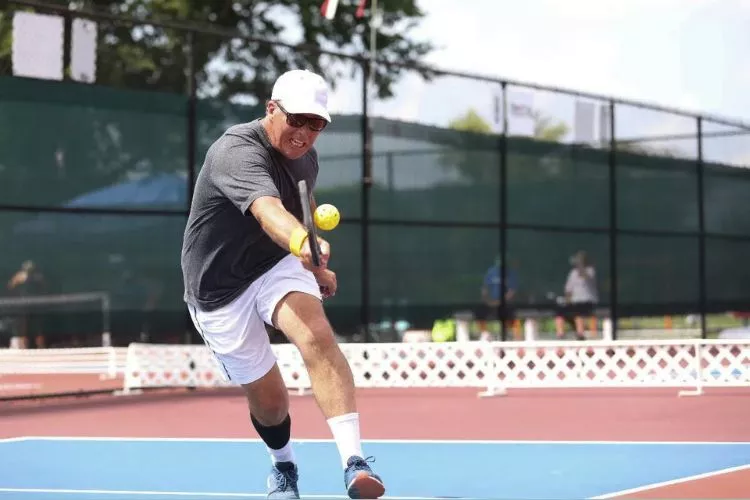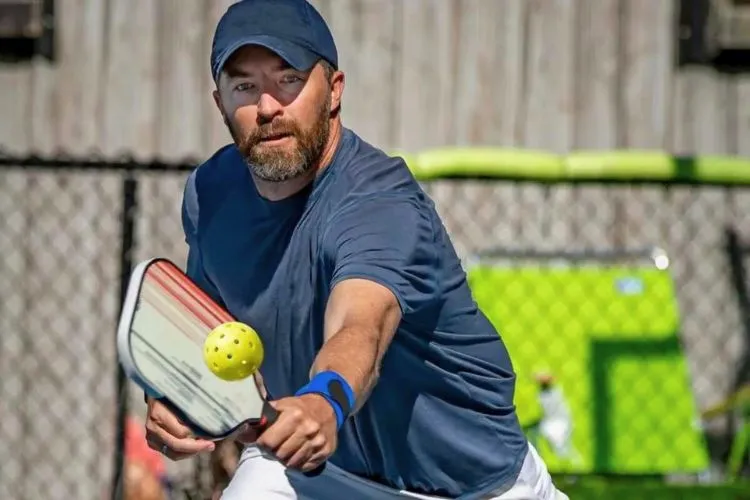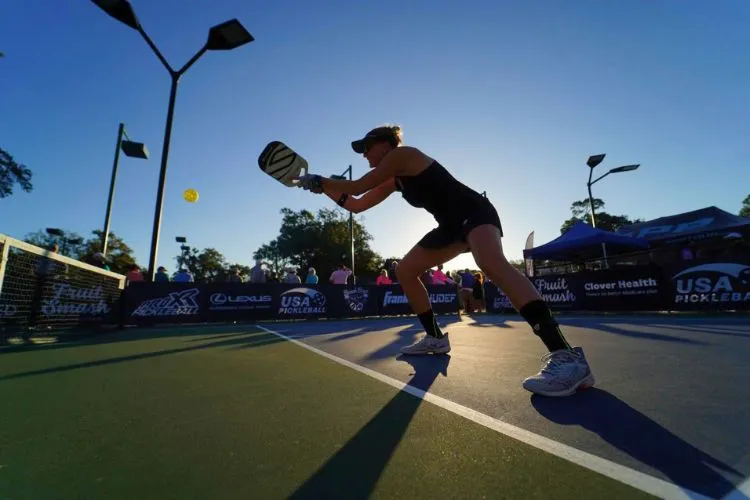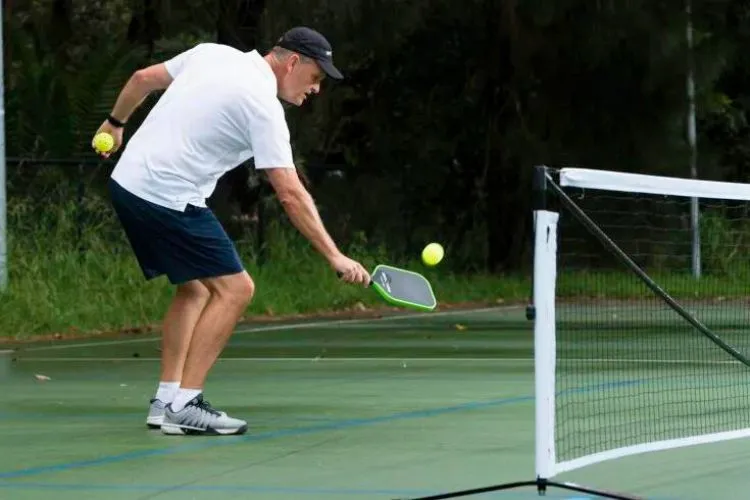In the dynamic and fast-paced world of pickleball, maintaining a laser-sharp focus can dramatically escalate your game.
Regardless of your skill level in the sport, harnessing the power of concentration could be your game-changer.
In this article, we delve into effective ways on how to increase focus in pickleball, exploring everything from mind-body techniques to strategic gameplay.

Whether you’re a novice or an advanced player, you’ll find valuable insights to help you remain unruffled during high-pressure moments, navigating across the court with greater precision, agility, and confidence.
how to increase focus in pickleball?
Pickleball demands mental strength and physical agility. Sharpening your focus is essential to excel in the sport.
Here are practical and implementable tips to help you concentrate better while playing pickleball.
Create a Pre-Game Routine
Establishing a pre-game routine can help you feel focused and prepared. Some practical ideas include:
- Stretching and warming up your muscles for 10-15 minutes
- Reviewing your strategy for the game
- Taking deep breaths to calm your nerves
Use a Trigger Word
A trigger word or phrase is a powerful tool that can help anchor your focus during a pickleball match. Choose a word or phrase that resonates with you and reminds you to concentrate. Examples include “eyes on the ball,” “steady,” “breathe,” “patience,” or “balance.”
The purpose of using a trigger word is to create a mental cue that brings your attention back to the game and helps you regain composure when faced with distractions or stress.

To effectively implement your trigger word, follow these steps:
- Choose your word or phrase: Select a word or phrase that is unique, meaningful, and easy to remember. It should be something that can instantly remind you of your ability to focus and stay present.
- Practice using it during drills: Start incorporating your trigger word while practicing. This will help instill the association between the word and refocusing your attention.
- Utilize it during gameplay: When you notice your focus wavering, use your trigger word to calm your mind and redirect your attention back to the game. It may help to repeat the word silently or under your breath as needed.
- Evaluate its effectiveness: After a few games, assess how well the trigger word is working for you. If you notice a significant improvement in your focus, continue using it. If not, experiment with different words or phrases until you find one that has the desired effect.
- Incorporate it into visualization exercises: Include your trigger word in any pre-game mental preparation or visualization exercises to strengthen its association with focus and concentration.
By choosing and consistently using a suitable trigger word, you will train your brain to associate this word with heightened focus and control. This will enable you to quickly regain your composure and concentrate on executing your best strategy on the court.
With regular practice and diligent application, a trigger word can become an invaluable tool to help elevate your pickleball performance and enhance your overall enjoyment of the game.
Schedule Regular Drills
Incorporating specific drills into your practice sessions can significantly boost your attention on the court. By working on various aspects of your game, you can improve your overall pickleball skills, which will lead to increased focus and better performance.
Here are three important drills to include in your training regimen and how to execute them effectively:

Blocking Practice to Enhance Reaction Times: Blocked shots are crucial to counter your opponent’s powerful shots like volleys or drives.
- Set up for the drill: Have a partner or a pickleball machine deliver powerful shots at you from the other side of the court.
- Position yourself at the non-volley zone line facing your partner or the machine.
- Train yourself to instinctively raise your paddle to block the incoming shot. Focus on using a stable grip and quick reflexes.
- Aim to return the blocked shot cleanly and within the court boundaries. The goal is to improve your reaction time and control while under pressure.
Dinking Drills for Precision and Control: Dinking is a crucial soft shot technique in pickleball that can catch your opponents off-guard and help maintain control of the game.
- Set up for the drill: Stand at the non-volley zone line facing your partner or a pickleball machine.
- Practice delivering soft dinks that arc just over the net. Focus on your control and aim to land the ball within the non-volley zone on the other side of the court.
- Consistently practice dinking with both your forehand and backhand to improve your overall dinking skills.
- Progress to dinking under pressure by having your partner or the machine send mixed shots (drives or lobs) to practice transitioning between dinks and other shots.
Third Shot Drop Practice to Develop Consistency: The third shot drop is an essential element of pickleball as it enables you to transition from the backcourt to the net, potentially gaining a positional advantage.
- Set up for the drill: Stand on the baseline, with a partner or a pickleball machine set up near the net on the opposite side of the court.
- Focus on executing a gentle shot that arcs over the net, drops into the non-volley zone, and forces your opponent to hit upwards.
- Practice aiming for different locations within the non-volley zone to enhance your precision and control under various game situations.
- Develop consistency in your third shot drops by allocating a set number of attempts during each practice session and aiming to increase successful shots over time.
Incorporating these specific drills into your regular practice sessions will not only help sharpen your attention on the court but also improve essential pickleball skills for a more competitive edge.
By mastering blocking, dinking, and the third shot drop, you’ll be better equipped to handle a range of game situations, positioning yourself for success in pickleball.
Minimize Distractions During Practice
Creating a conducive practice environment can help you learn to focus better:
- Turn off or silence your phone during practice
- Use noise-canceling headphones, if needed
- Choose a specific time for practice and stick to it
Implement Mindfulness Techniques
Mindfulness exercises help you pay attention to the present moment. Try these techniques:
- Focus on your breathing for 2 minutes before a game
- Pay attention to the physical sensations in your body, like the touch of the paddle or your feet on the court
Split the Court Into Zones
Divide the court into zones to focus on specific shots and strategies. Work on serving into particular zones, aiming lobs, and returning fast shots with precision for each designated zone.
Utilize Peripheral Vision
Developing and utilizing your peripheral vision during pickleball gameplay is essential to maintaining awareness of the entire court, tracking the ball, and keeping an eye on your opponents and partner.
Training and strengthening your peripheral vision can help you stay focused and make more informed decisions when playing. Here’s a detailed guide on how to effectively practice and utilize peripheral vision in pickleball.

Train Your Peripheral Vision with Exercises: Use these exercises to sharpen your peripheral vision skills:
- Ball Toss Drill: Stand facing your partner at arm’s length. Toss a ball back and forth without looking directly at each other. Focus on using your peripheral vision to catch the ball.
- Tennis Ball Wall Bounce: Stand one arm’s length away from a wall with a tennis ball. Bounce the ball off the wall and catch it using only your peripheral vision.
- Cone Peripheral Awareness Drill: Set up multiple colored cones in a circle formation around you. Keeping your head straight, identify the colors of cones in your peripheral view without turning your head.
Apply Peripheral Vision in Gameplay: When practicing or playing a match, consciously work on the following aspects to incorporate peripheral vision into your game:
- Focus on maintaining a soft gaze during rallies. This will allow you to better utilize your peripheral vision and keep track of the ball, your opponents, and your partner.
- Be aware of your surroundings. Observe your opponents’ movement, court position, and any obvious strategic cues without losing sight of the ball or diverting your attention from the game.
- Communicate with your partner using your peripheral vision. Coordinate your movements, shots, and defensive plays without having to continuously look at each other.
- Boost your decision-making on the court. With improved peripheral vision, you can more accurately judge the best shot to take, determine the ideal moment to attack, or decide when to switch to a defensive stance.
By consistently training and implementing peripheral vision in your pickleball gameplay, you’ll sharpen your focus, improve your situational awareness, and enhance your ability to respond effectively to your opponents’ strategies.
This added advantage will become an invaluable asset as you work towards elevating your game to new heights.
Set Personal Goals
Establish clear, measurable goals for your pickleball performance. It might be improving your serve accuracy or winning a certain number of matches. Having practical objectives allows you to concentrate on what matters most during gameplay.
Record Your Games
Film your pickleball matches and analyze your performance afterward. This helps reveal areas that need improvement and reinforces the importance of staying focused on court.
Reward Yourself
Acknowledge your progress and reward yourself as you achieve your goals. It could be something as simple as treating yourself to your favorite meal or watching a movie. Recognizing your accomplishments can encourage you to stay concentrated and committed to improving your game.
With these ten practical and implementable tips, you can hone your concentration and elevate your pickleball performance. Consistent practice, mindfulness techniques, and goal-setting will keep you focused on the court and help you unlock your full potential in the sport.
Conclusion:
Enhancing focus in pickleball is achievable by incorporating strategies such as visualization, trigger words, regular drills, and peripheral vision into your practice sessions and matches.
Commitment to improving mental and physical aspects of your gameplay will not only result in heightened focus but also lead to increased enjoyment and overall success on the court.
Observe the progress in your skills and awareness by consistently implementing these approaches, and you’ll find yourself becoming a more competitive and attentive pickleball player in no time.

Pickleball’s more than a game to me—it’s a passion. I write, sharing its highs and lows, the thrills and the lessons. Some tales might draw you to the court, while others give a hint of the game’s magic. So, curious about my journey? Ready to dive deep into the world of pickleball with me? Let’s go.
